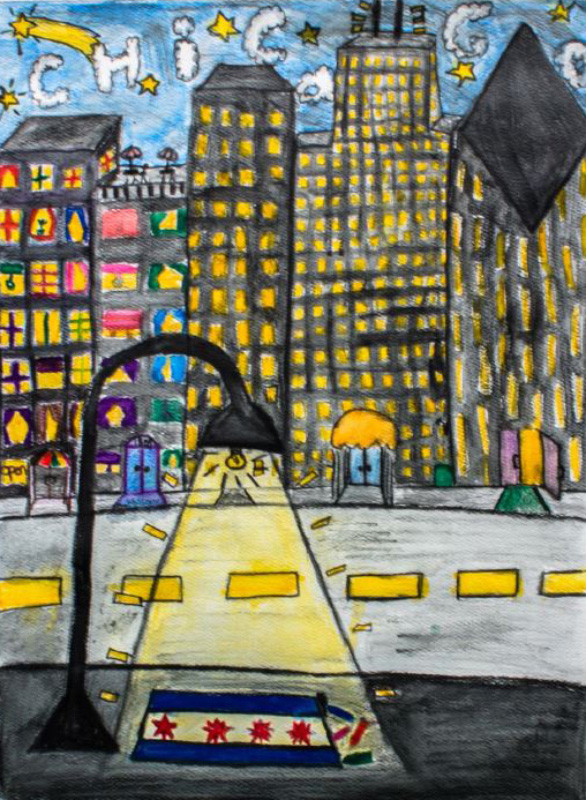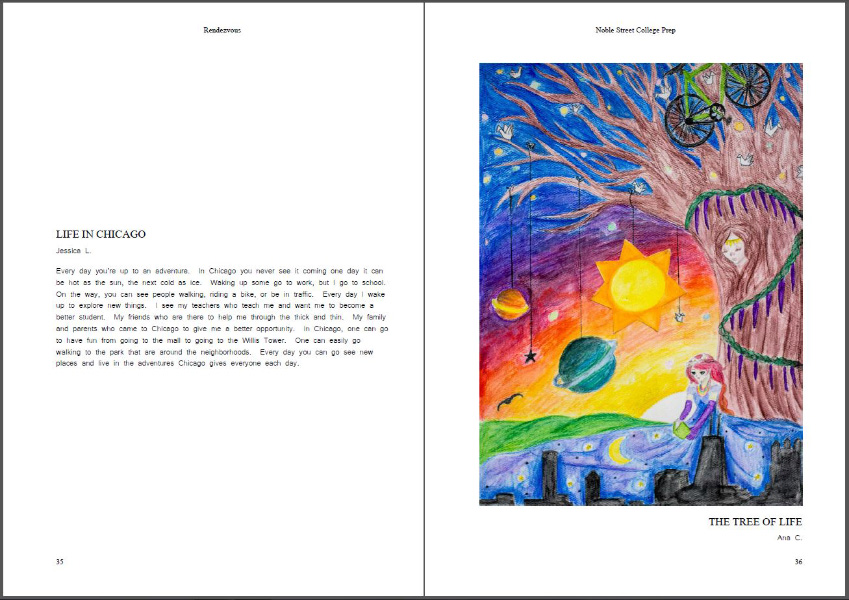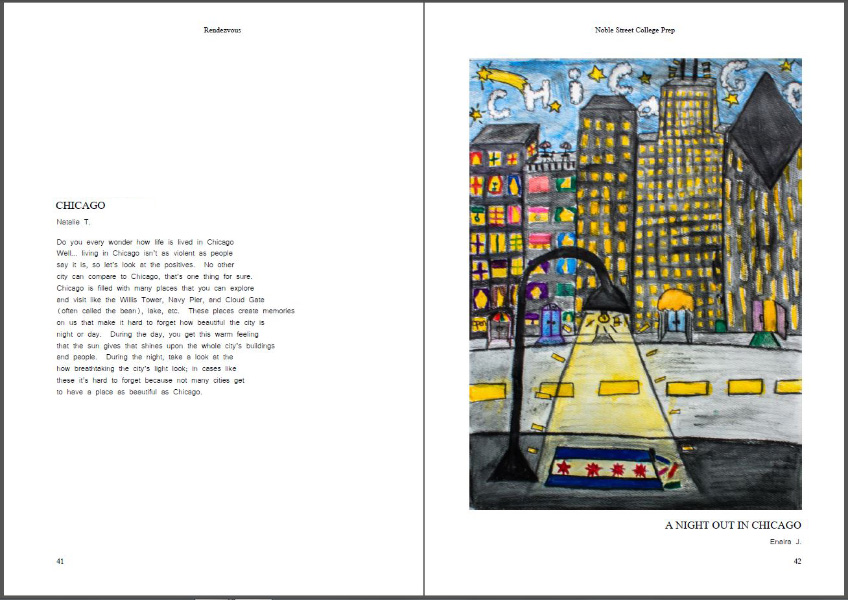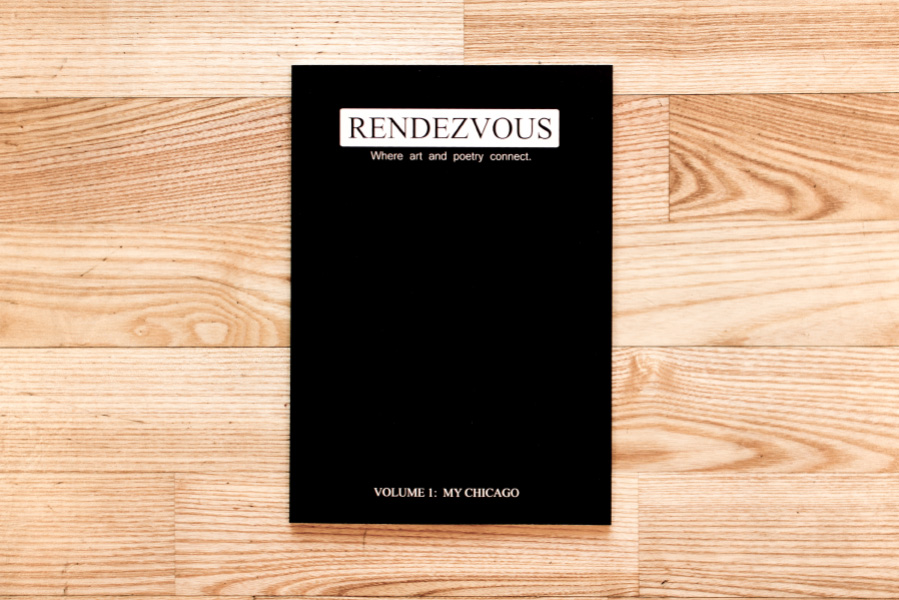Contemporary Book Publishing
High-school students create their own publication in an exploration of big ideas.
By Joshua N. Hoering

Art is like poetry. It seeps in slowly, connecting us to bigger ideas, pushing us into a space of contemplation and imagination. This space is the place where artists thrive; a place all art students can discover. This project explores the possibilities of publishing a book of student poetry and illustrations. The illustrations are inspired by the poetry, but the deeper connection is a subject relevant to your school’s community that students are passionate about. In publishing a book, students’ perspectives of an issue are shared to their community and beyond, so their voices and visions are known.
By definition, contemporary art is the art of today, produced by artists who are living in the twenty-first century. It provides an opportunity to reflect on contemporary society and the issues relevant to ourselves, and the world around us. This project is about capturing those reflections from students about issues relevant to them and publishing their work in a book that can be shown to anyone.

For Students:
- Describe, analyze, and interpret poetry from history and poetry created by other students.
- Synthesize personal and group understandings of poetry to develop an illustration that clarifies or complements a poem.
Interpret illustrations and graphic designs to assess their effectiveness at representing ideas. - Apply materials, tools, and processes from a variety of media (watercolor, digital photography, drawing) to produce an original artwork.
- Evaluate artworks in critiques and respond to constructive criticism.
- Analyze written critiques on their effectiveness.
For the teacher:
- Curate artwork and poetry created by students.
- Advocate artwork and poetry created by students to and beyond a school’s community.
Documentation + Assessment Suggestions
One of the central ideas behind this project is to document student poetry and artwork in the form of a book. Oftentimes artwork is showcased in the form of an exhibition, which offers great experiences in its own right, but sometimes the space for displaying student artwork in a school is limited.
To assess this project, written critiques and grading rubrics work well. Critiques are used for formative assessment, which is designed to help students learn perspectives outside their own to see where they can improve their work. Grading rubrics work best as a way to assess the learning and use of a skill taught in class.
To reflect on this project, I used a simple one-sheet handout which helps students think about their performance, effort, and how they perceive the results of their efforts.
Learning Activities
Discussing big ideas is where this project begins. Think Love, Play, Structure, and Legacy.
Begin with a discussion with students about these ideas to get their brains reeling. When subjects like these open up discussions, life rushes in. It’s hard to discuss “Structure” without discussing laws, habits, comfort, and chaos, which is excellent for sharing different perspectives from students’ backgrounds and experiences in the classroom. To do this, I recommend having students write 10 words related to a subject independently followed by small group discussions to find 5 words in common. Then, writing all 5 from each group on the board with the intention of narrowing it down to 5 words that represent the class’s connection to the big idea.
Writing is the next stage, where students hone their perspectives of their subject by writing poetry, sometimes for the first time. An introduction to styles and formats is helpful, but the inclusion of song lyrics is even more so. Explain to students that their poems can be in the form of a letter, a song, or even a haiku. Once these possibilities are allowed, students will approach writing poetry with ease and excitement. Consider reading some Shakespeare aloud, followed by a song that defies poetic tradition. Remind students that sometimes the ideas and emotions behind expression are of the utmost importance. Focus on the big ideas at hand.
Once poetry is written, teachers should sift through to find the examples that seem most fully developed. Remove the names, and distribute back randomly to students. This allows students to connect with the big ideas being expressed and less with the person who wrote the poem. Save it as a surprise at the end! Then, have students analyze the poems. There are a lot of resources out there on how to analyze poems, but I’ve created a handout which may work for you. It’s important that students have a thorough understanding of the poem they’ve been assigned to illustrate.
Now, it’s time to draw and paint. Beginning with thumbnail sketches is advised, as it pushes divergent thinking strategies and offers great opportunities for critiques and small group discussions which can lead to leaps in creativity. Then, teach students skills in painting, like color mixing and water dilution. How well a student utilizes these skills can be part of your assessment. This, of course, comes later.
Throughout the illustration process, facilitate formative critiques. Written critiques followed by a critique analysis is one of my favorite ways to go, as it’s personal and deliberate and helps students learn the skill of constructive criticism. I’ve included one handout for the critique and another for analysis.
Once the illustrations are complete, high resolution photographs should be taken of the work using proper lighting. Plug these images into the book template I’ve included and start organizing the book. Students can also do this, calling for a curator to emerge from the student population.
When your book files are finalized, send them off to your printer of choice. I used Amazon’s CreateSpace, which was great because the company prints each book as it’s ordered. Sell the books for fundraisers or give them away as gifts. They last longer than art exhibits and can be passed down from generation to generation.

Materials + Supplies
Theme Discussion: whiteboard or chalkboard
Creative Writing: pencil and paper
Illustrations: watercolor paper, watercolor pencils, watercolor brushes, water containers, graphite pencils, erasers, drying rack, paper towels, water
Critiques: handouts and pencils
Book Editing: digital camera, computer, Adobe Illustrator, Microsoft Word
Book Publishing: Amazon’s CreateSpace
MCA Connections
Use the MCA’s permanent collection website for artist inspiration.
Take a field trip to the MCA to view a curated exhibition of multiple artists to learn about how artwork can be connected to a single theme. Use the theme of the exhibition you view as a starting-off point for discussion of how curators collect artwork from multiple contemporary perspectives and how they all contribute to changing people’s ideas of a subject or theme. Encourage students to start thinking like a curator!
Resources
Project Worksheets:
- Poetry Prompts
- Poetry Analysis
- Critique Form - Multiple Work-in-Progress Peer Critique
- Critique Form - Review + Analysis
Artwork References:
- MCA Permanent Collection
- Luke Best (The Curse of the Whale)
- Lilli Carré (Illustration for Slate Book Review)
- Patrick Hruby (Illustration for the New York Times OpEd and Leters)
- Marjorie Newnham (Illustration for "Why Run" by Megan Domaille for Howies)
- Stefan Sagmeister (Lou Reed Poster)
- Maurice Sendak (Where the Wild Things Are)
- Otto Steininger (Spammers Posing as Your Facebook Friends)
- Mark Weaver (How to Destroy Angels)
- Dan Woodger (Illustration for article on Japan's struggle to preserve culinary heritage)
- Milton Glaser (What Happens in Darfur Happens to Us)
Poetry:
- Stephens, J. (2014). Glory [Recorded by Common; Legend J.]. Selma. [Digital Download]. New York City, New York: Columbia Records.
- Craig, W.J. (1914). “[All the World’s a Stage].” The Complete Works of William Shakespeare. London: Oxford University Press. Bartleby.com, 2000.
- Stills, S. (1967). For What It’s Worth [Recorded by Buffalo Springfield]. Buffalo Springfield. [Vinyl Record]. Hollywood, Atco.
- Poe, E.A. (1903). A Dream Within a Dream. The Works of Edgar Allan Poe, The Raven Edition, Volume 5. New York: P. F. Collier and Son.
Articles:
- Krathwohl, D. David. (2002). A Revision of Bloom's Taxonomy: An Overview. Theory Into Practice, Volume 41, Number 4. College of Education, The Ohio State University.
- Eisner Elliot. The Arts and the Creation of Mind. 2002. New Haven, England: Yale University Press.
- Long, T. W. (2008). The full circling process: Leaping into the ethics of history using critical visual literacy and arts-based activism. Journal of Adolescent and Adult Literacy, 516(6), 498-508.
- Strand, K. (2006). The heart and the journey: Case studies of collaboration for arts integrated curricula. Arts Education Policy Review, 108(1), 29-40.
- Parker, J. (2005). A Consideration of the Relationship between Creativity and Approaches to Learning in Art and Design. International Journal of Art and Design Education, 24(2), 187-198.
Joshua N. Hoering
Noble Street College Prep
Joshua N. Hoering has been an arts educator and administrator for over 9 years and is based in Chicago, where he teaches at Noble Street College Prep. He directs community projects, hosts professional development sessions, organizes art exhibitions, and is a visual artist. He holds a Master of Science in Education from Indiana University with experience rooted in nonprofits and art museums, with a solid understanding of how to improve community and student engagement with the arts. His work has been supported by the Museum of Contemporary Art, Chicago, the City of Bloomington, Indiana, the Indiana University Art Museum, and the Strategic National Arts Alumni Project (SNAAP).
Colleagues know Joshua as a highly creative curriculum designer who devotes his time to developing a strong understanding of students and communities to provide strategic education plans that maximize creativity and engagement in the arts. He’s at his best when building community partnerships and collaborating with others on projects that serve communities and help individuals become their best selves. To learn more about Joshua, visit www.joshuahoering.com
Joshua reflects on his creative process;
The idea for developing a book project came out of the lack of connection between creative writing and visual art at the school where I teach, and the opportunity I saw to make that connection. From my end as the teacher, a lot of time was spent crafting the lesson plans and editing the book itself. I’ve designed and edited several books, but the end product for this project was much more ambitious than a lot of community art projects I’ve designed and implemented, which was great for personal growth. A secondary purpose of developing a book project was to create a process to document artwork and poetry that expresses students’ current perspectives of the Chicago we live in today, in 2015.
The beginning of the Rendezvous Book Project was all about preparation. We discussed principles of color theory, how to analyze poetry, and how to think divergently and convergently in efforts to be creative. The last and final discussion was in the form of a “chalk talk,” a discussion where students developed themes for their illustrations as I recorded students’ ideas. In my mind, it was a way to help identity for each class and an opportunity for students to express their perceptions and perspectives of their lives in Chicago.
The first task was to write down 10 things they thought of when they heard of the word “Chicago.” Words could be as simple as “taco” or as complex as “diversity.” Their lists only took a few minutes to develop, but what happened next was energizing. Students synthesized their lists into 5 themes in groups, then synthesized those ideas into 5 themes that would represent the entire class.
When students began discussing their ideas in groups, they became passionate about their themes. They debated and worked as a team to refine their ideas to 5 words that accurately represented their perspectives. Class participation was at an all-time high. When I started writing their words down on the board, they began earnestly looking for connections. When I finished recording their words and began asking them to announce the themes they saw, they believed those 5 themes should be honest, accurate, and positive.
Students owned their themes more than I did, and they were proud. The 5 themes are designed to remind students every day what Chicago means to them, so that when they work on illustrations, their images will authentically express their reality. These themes represent not only these students, but also Chicago.
As a result of the project’s creation, I’ve connected with several other teachers who are interested in using the template I’ve designed to publish their own version of the book, which I find rewarding because the project is helping other school communities, not just the one I’m engaged with through my position as a teacher.
